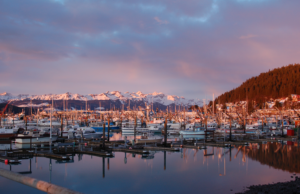By Lisa Matlock
Outreach Coordinator
As the skiff sailed across Cabin Bay, high-pitched twittering and piping sounds echoed over the water. Four football-shaped black birds with white wing patches on the water near the point seemed engrossed in calls emanating from speakers and several decoys sitting rigidly on the rock. One of the teens pointed and yelled, “There they are!”
Sam Stark, an Oregon State University researcher leading the teens on their bird adventure, smiled and congratulated her on her keen eye. Stark developed several activities for these lucky middle schoolers, to teach them how scientists work to restore populations of wildlife affected by a major oil spill.

